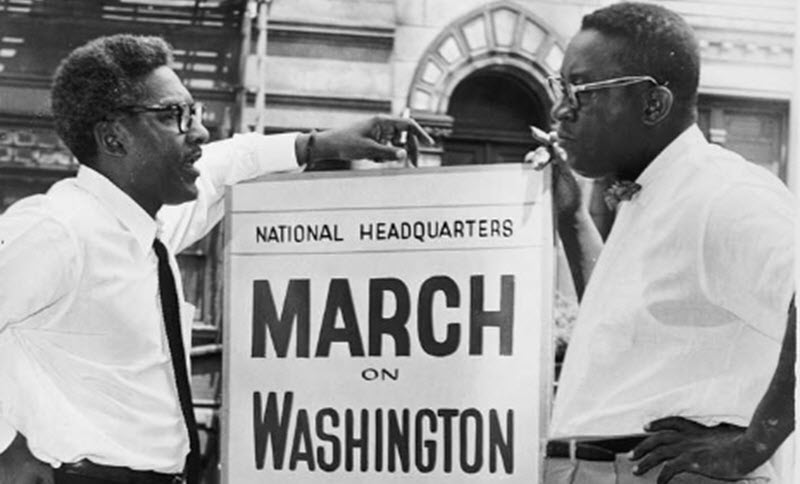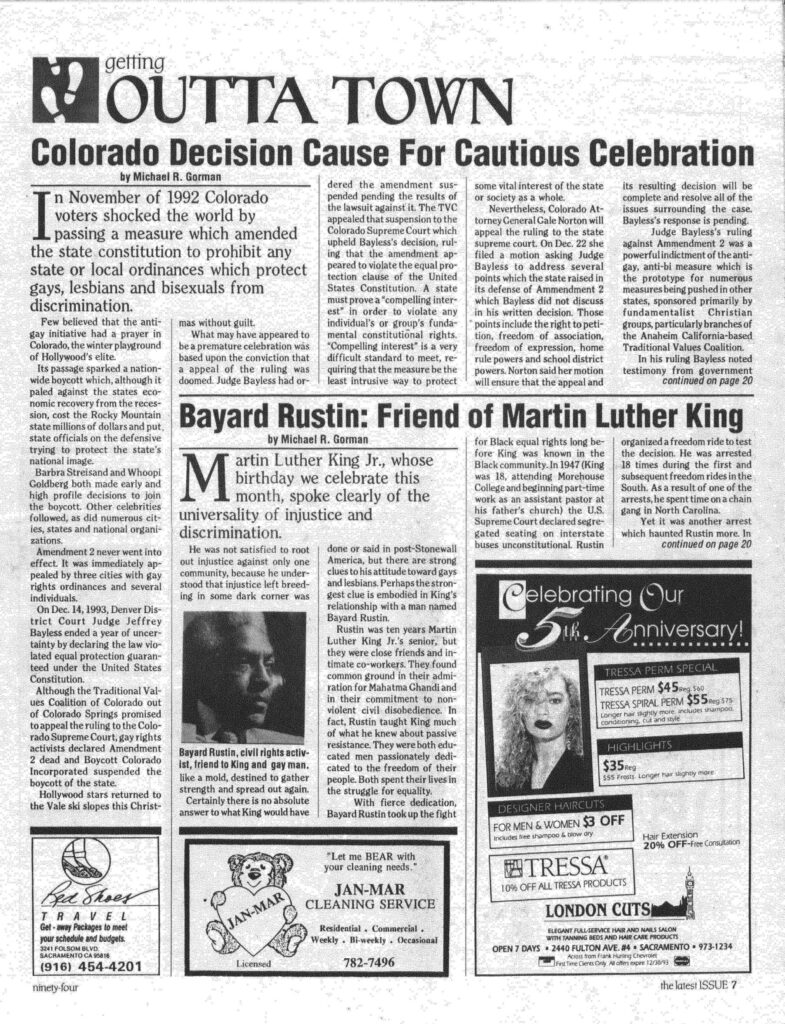| By Joel Meredith, Course Lecturer, Purdue University |
Looking back on my undergrad years, there’s plenty of nostalgia. Eighties nights at a downtown dive bar, midnight Tim Hortons runs—and somehow managing to wake up for class after three or four hours of sleep. But even then, I wouldn’t describe my college experience as typical.
The Princeton Review consistently ranked my alma mater among the nation’s least-welcoming schools for LGBTQ students. As one person out of a small handful of “out” students, I found myself constantly called upon to advocate, educate, and organize. Despite the efforts of previous classes, we were the first who were able to found, and maintain, a lasting gay-straight alliance-style organization on campus.
Eager for allies, we coordinated with the Multicultural Student Advisory Board for an event where we screened a documentary about Bayard Rustin, one of the chief architects of the 1963 March on Washington. He had worked with Martin Luther King, Jr. and had a track record as a successful organizer. But with the spotlight shining brighter than ever on Rustin that summer, he was forced into the background. Why? Because he was gay.
With the new biopic Rustin streaming on Netflix, it’s the perfect time to revisit the legacy of a visionary organizer without whom we may not have King’s famous “I Have a Dream” speech committed to memory. Join me on my journey through Gale’s Archives of Sexuality and Gender as I explore the tensions Rustin experienced as a leader and an outsider within the civil rights movement as well as the triumphs and legacy he’s passed down to activists today.
Navigating Between Worlds
After 60 years, we recall the March on Washington as a moment of triumph, a rallying cry that galvanized the nation. Its success, however, was far from assured. It required a broad coalition—and compromise.
Rustin was involved from the start, having worked with both King and A. Philip Randolph in the 1940s. This 1994 article by Michael R. Gorman in the Gale Archives of Sexuality and Gender reflects on Rustin’s friendship with King and how his Quaker upbringing was key to King’s study of Mahatma Gandhi and the adoption of his philosophy of nonviolence.
Gorman, Michael R. “Bayard Rustin: Friend of Martin Luther King.” The Latest Issue 5, no. 9 (Mid-January 1994): 7+. Archives of Sexuality and Gender (accessed January 8, 2024). https://link.gale.com/apps/doc/MXAJMS312496105/AHSI?u=seoblogs&sid=bookmark-AHSI&xid=4b887f28.
Despite Rustin’s long-standing relationship with these giants of the civil rights movement, his past haunted him. Rustin had been a member of the Youth Communist League, one of the only organizations in the country where he could find a community dedicated to organizing across racial boundaries.
There was, however, something more worrying for Roy Wilkins, the executive secretary of the NAACP. He believed that Rustin was a liability due to his arrest in 1953 for public indecency under the nation’s so-called anti-sodomy laws. In Wilkins’ eyes, Rustin’s personal life could derail the entire project.
As a compromise, Rustin stepped aside from his role as lead organizer and took a backseat to Randolph. Undeterred, Rustin remained a key figure as preparations for the August 28 march swung into full gear.
Rustin and Randolph understood the national mood. As violence and turmoil roiled, they believed that a hunger for justice and progress would bring people to the streets. They were right.
What happened next is the better-known part of the story. Somewhere around 250,000 people converged on Washington, D.C. from across the nation. By and large, that’s what we remember. That moment. Those iconic images and soundbites of King at the podium speaking prophetic truth in the nation’s capital.
Tracking Movements from One Generation to the Next
After spending some time in the Gale Archives of Gender and Sexuality, I am reminded that history is not about moments, it’s about movements. History is not a series of random, dissociated events, and progress is rarely made by lucky coincidence. Rather, it’s the result of people showing up day after day and year after year—people like Bayard Rustin.
Although we remember Rustin for his leadership within the civil rights movement, he also played an important role in the LGBTQ community. He set an example of authenticity at a time when the law and social pressure kept countless millions in the closet. He modeled effective compromise while remaining true to his values and vision.
When the nation prepared to honor the 30th anniversary of the 1963 March on Washington, LGBTQ activists organized to ensure that Rustin’s contributions as a gay Black organizer were not overlooked. The Archives of Sexuality and Gender show that the Bayard Rustin Commemorative Alliance was central in leading the charge.
Uncovering the Bayard Rustin Commemorative Alliance made me curious to know more about this organization and its executive director, Gregory Adams. I knew it might take more advanced research skills to find primary sources that spoke of this organization since it was lesser known and short-lived. A simple Google search wouldn’t reveal what I was after. Gale’s Archives of Sexuality and Gender, however, boasts a wealth of material from local LGBTQ newspapers across the United States, opening new research avenues.
Like Rustin, Adams was an organizer on a national stage. In 1993, he served as the communications director for the March on Washington for Lesbian, Gay, and Bi Equal Rights and Liberation. Participation estimates vary, but it ranks among the largest in the nation’s history.
A year later, the Bayard Rustin Commemorative Alliance organized Double Exposure. Billed as “a national town meeting,” the event invited attendees to explore “the politics of racism and discrimination within lesbian and gay America,” something both Adams and Rustin understood firsthand.
A 1995 piece written by Adams reflects on these tensions. He proudly writes what it felt like to participate in the Million Man March. While white members in the LGBTQ community expressed consternation at Adams (figuratively) linking arms with Louis Farrakhan, he instead spoke about what it meant to be in solidarity with his community as his full, authentic self as an openly gay Black man.
Adams’s final piece in the Archives of Sexuality and Gender further explores the question of racism in the LGBTQ community. “The images of hundreds of thousands of black men gathered at the U.S. Capitol for the historic Million Man March,” he writes, “were moving and empowering for some; uncomfortable and threatening for others.”
His words evoke wildly divergent interpretations of the Black Lives Matter protests following the murder of George Floyd in the summer of 2020. The archives remind us that we have been here before. But they also show us how far we’ve come—and help us think more critically and constructively about the work it takes to get where we want to go and that allyship is often essential to the success of any social movement.
Want to learn more about the intersection of the civil rights and gay liberation movements? Explore the links provided in this blog.
Interested in bringing primary sources like Archives of Sexuality and Gender to your academic institution? Contact your Gale representative.
Meet the Author
Joel Romero-Meredith is an English PhD student and French lecturer at Purdue University with more than a decade of professional writing and marketing experience. In his free time, you’ll find Joel traveling, spending time with his husband, and extending his Welsh and Spanish lessons streak on Duolingo.



